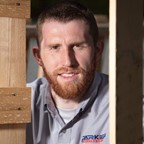Next-Generation Industry Movements

Editor’s Note: The free exchange of ideas and opinions is essential to the well-being of any organization. RIA members are invited to share their views and opinions on industry issues in this column. Responses and submissions for future columns should be sent to: Alexa Schlosser, managing editor of C&R, at aschlosser@restorationindustry.org. The views and opinions expressed herein are those of the member and not necessarily endorsed by RIA.
Have you noticed how carriers and reviewers are telling you more frequently: “We don’t pay for that!”? Items that have been acceptable for decades now get scrutinized: emergency service calls, air scrubbers, PPE, travel time, cleaning and disinfectant application, containment, hardwood floor drying efforts, equipment decontamination and many more. They allege, “You’re the only contractor around here that charges me for that.” The list gets seemingly longer every few months, and one restorer has tiredly declared, “It has taken the wind out of my sails.”
Today, there are a number of groups in the industry with a similar mission or movement: to change the combative and frequently unfair dialogue found on many insurance claim settlement efforts. If you actively participate on social media, you may have even been wrapped up in one or more emotional online dialogues. These groups have only been around for about a year or so, and they have gained a relatively large and energetic base of restorers. Having been privileged to view the participation metrics on the Facebook pages of these groups, some threads attract between 1,000-2,000 people with topics related to restoration industry challenges.
What Gave Rise to the Industry Movements?
In my opinion, there are two reasons why these groups have formed. First, there are ever-increasing pressures from carriers to compromise in protocol and concede rightful revenue. These unrealistic expectations that are based on individual carrier “guidelines” generally have no legitimate support. It is very difficult to work with their guidelines, especially as they are often enforced by dogmatic, undertrained claims representatives who do not possess the education and experience necessary to competently restore a water damage claim. Many feel these pains; they are getting worse, and it appears no one is doing anything about it.
Cue the social media groups and industry movement that is appearing online. Through these online groups — contractors who have felt alone against the insurance company giants — can receive the support and courage to stand up against them. The support and free exchange of information helps them realize they are not the only restorers who conduct responsible restoration in accord with industry standards and practices. I have seen many people say that involvement in these groups has enabled them to see improved increases in their bottom line. One restorer claimed that through the information learned in the networking group, they had been able to add more employee benefits, including health care, after struggling for years just to stay afloat.
Second, there seems to be an apparent void in the industry for practical contractor support in near realtime. Thousands of restorers have flocked to the quickly growing online movement with hundreds attending the group’s conferences around the country because they were so excited that there was finally a means for them to communicate and network with other competent restorers.
But, Wait, Isn't That What the Restoration Industry Association Is — And Has Been for the Last 70+ Years?
As readers of C&R, many of you probably knew that, but there is an entire assembly of restoration contractors out there who have no idea RIA exists or what it does. This may be partially due to RIA’s poor visibility. To be brutally honest, some have expressed their negative stigma associated with the RIA membership, even using such phrases like “goodold boys club.” There was a void in the industry — be it perceived or real — for these networks to form.
Yes, I said negative stigma. I have worked in this industry for many years, with the last four years owning my own restoration company. RIA’s Strictly TPA Summit was the first RIA event I ever attended. First-time attendees to an RIA event were asked to raise their hands. Roughly one-third of the room identified themselves. Why did this event attract so many new attendees? The conference theme spoke to the largest pain point in the restoration industry, and the attendees needed solutions.
Months ago, I asked a simple question in one of the online groups: “What is your opinion of RIA and what they do?” I made it clear that there was no right or wrong answer, and I just wanted to know what the perception was of the restoration community within the group. Most were not only negatively associated, but just plain inaccurate. One response was, “I feel that RIA is more for the carriers and TPAs.” If this is what the restoration industry’s nonmember believe to be true, RIA clearly needs to work on its public image, and we, as members, need to help our colleagues more accurately understand our industry’s trade association.
Somewhere between pressures associated with the increasingly stringent and unfair insurer guidelines and the glaring lack of association felt by many within the industry, there was room for interest and rapid growth among mostly next-generation restorers. A movement emerged.
I have been asked the same question several times, typically from the older generation: What is “powering” this movement? I believe the answer is passion.
The strong, barely controlled and sometimes unbridled passion felt by the most active members of these groups is used to wrestle control back from the carriers that have unfairly manipulated the contractor’s trade. Many in these groups feel the real battle is against the unrealistic carrier’s “acceptable billing practices.” They feel the best way to fight the insurers is to stand together. Whether enforced by TPA claims reps that have virtually no realworld understanding or a desk adjuster that was just hired a couple months ago and is blindly enforcing guidelines with no understanding of legitimate business practices, the outcome is the same. Restorers are spending more energy “negotiating” the final invoices for less profit than ever before.
For the passionate non-RIA member, it seems the best way to correct these industry challenges is with open communication among fellow restorers. Social media offers up an unparalleled communication platform where a single post can reach thousands of people. It is not uncommon for a post to be made on an industry hot topic and have hundreds of responses pour in within hours. Replies can include how others have handled the same situation successfully or what further complications may arise. It is worth noting that the quality of the advice offered can range from brilliant to ridiculous. The reader must use lots of discretion.
Over the last year, it has been astounding to observe how social media’s information exchange effectively speed positive company development. I have enjoyed several positive benefits through changes learned by the experiences of other who described their successes online.
RIA and Me
Admittedly, I am very new to RIA. I have attended two RIA conferences and ambitiously obtained my CR designation. I have met many individuals at these events who have already left lasting impressions on me.
Conversely, I have also attended three conferences hosted by a few of these online groups. I am of the opinion that RIA generally consists of a quality of members that is unrivaled. Many RIA members have been involved in the industry and running successful restoration companies for many decades. These same members have the largest ability to influence the industry positively with the knowledge they have acquired.
The demographic differences between RIA membership and those within these online movements is a striking contrast. I observed the average age of participants within these online groups is under 35 years of age according to Facebook demographic information. I would invite RIA members to notice the average age and experience at the next RIA conference. It is indeed impressive to associate with such a distinguished group of professionals.
In recent years, local competition has become less collaborative and more adversarial, especially as insurers pit us against each other in our own race to the bottom. Instead, we should adopt philosophies of cooperation that can help us stand our ground when we hear, “You’re the only one who charges me for that!” I try to have good-natured relationships with nearly every restoration company in my area. In response to objections like the one above, I offer to coordinate a three-way call with any one of these various companies. They typically decline the offer and release payment in full without further argument.
In this information age, there are entire new avenues and expectations for an association. The next generation demands availability, faster response and more opportunity for networking, community involvement and relationship building. It doesn’t matter if you like it or not; it’s the truth. Because of the slow adoption of these platforms and technologies coupled with a slow release of information, it has allowed other potentially competitive organizations to gain foothold. How does RIA capture this market full of the next generation of restorers?
One way is members need to reach out. The “exclusionist” undertone associated with the RIA needs to be reversed. This can be done through example — by showing others in the industry the quality of the RIA member by your interaction. They need to know what RIA has done for you and what it is doing to help improve the industry. This is then followed up with a sincere invitation to your competition to join RIA and get involved. This is a member call to action: Get involved in the industry community.
 Parker Olsen, CR, is the president of Parker Restoration. He has served the industry on the Membership and Young Professional Restorers committees. Olsen is a leading contributor in many online forums to those looking to improve their knowledge in the industry. To reach him, visit facebook.com/parker.b.olsen or call 509-331-9000.
Parker Olsen, CR, is the president of Parker Restoration. He has served the industry on the Membership and Young Professional Restorers committees. Olsen is a leading contributor in many online forums to those looking to improve their knowledge in the industry. To reach him, visit facebook.com/parker.b.olsen or call 509-331-9000.
